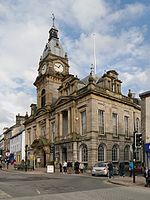The Barony of Kendal is a subdivision of the English historic county of Westmorland. It is one of two ancient baronies that make up the county, the other being the Barony of Westmorland (also known as North Westmorland, or the Barony of Appleby). In 1974, the entire county became part of the modern county of Cumbria and ceased to have an administrative function. At the same time, Kendal borough along with some other rural and urban districts in Westmorland was merged with the neighbouring parts of Lancashire, Furness and Cartmel, and also the Sedbergh Rural District of the West Riding of Yorkshire into the new South Lakeland district of the new county.
The barony is the remnant of the feudal barony whose caput was at Kendal castle. The feudal barony had its own complex evolution, determined by the evolution of the families that owned it. For some purposes, it was therefore once considered to include parts of the Barony of Westmorland that were possessed by the original lords of Kendal, such as at least parts of the ancient parishes of Barton St Michael, and Morland.
In modern times, before it was scrapped, the barony came to be divided into two administrative wards, Kendal and Lonsdale, centred on the old church towns of Kendal (sometimes referred to historically as Kirkby Kendal), and Kirkby Lonsdale, which are respectively geographically centred on the valleys ("dales") of the rivers Kent and Lune. The parishes of the two wards are as follows:
Kendal ward: Ambleside, Burton-in-Kendal, Grasmere, Grayrigg, Kentmere, Kendal, Windermere. (The parish of Kendal itself was large and contained 20 townships.)
Lonsdale ward: Kirkby Lonsdale











